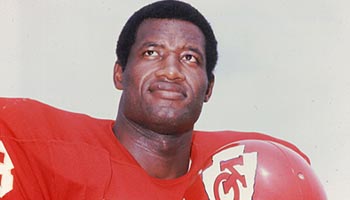Gladiator
By Bobby's third season in 1965, Stram felt he had enough defensive line strength to permit Bell to make the permanent move to linebacker. There he developed into super-stardom, winning either All-AFL or All-AFC designation the next eight seasons. During that period, Bell starred on two AFL championship teams, played in Super Bowls I and IV and was named to the last six AFL All-Star games and the first three AFC-NFC Pro Bowl contests. He was picked to the all-time AFL team in 1969.
"I just liked to play football, no matter what the position," Bell insisted. "But, if I had to pick one favorite position, it would be outside linebacker. I love to play defense and tackle people. Linebacker is one of the most difficult and challenging positions to play. You have to worry about the pass, the run, man-to-man coverage, containing the play, screens, and draws. It's a spur of the moment position. There is a lot of thinking there and a lot of responsibilities."
 |
|
Bobby Bell |
Bell also loved to handle the football, and he proved throughout his career that a linebacker's job really does offer that chance. He intercepted 26 passes in 12 years and returned them 479 yards, an average of 18.4 yards per return. He scored six times on interceptions, including a 38-yard jaunt against Boston in 1965 for his first pro touchdown and a 28-yard runback against Denver in his final 1974 season.
In 1966 in the season opener against the Houston Oilers, Bell blitzed quarterback Jacky Lee, forced a fumble and then scooped up the ball for a 32-yard touchdown. It was the second fumble return for TD in his career - the other coming two years earlier. A 53-yard return of an onside kick against Denver in 1969 gave him a nine-touchdown career total.
No one was more complimentary of Bell's multi-talented cavorting than his traveling roommate, the late defensive tackle Buck Buchanan, himself a five-time all-league star and fellow Hall of Famer.
"This guy is the best all-around football player I ever saw," Buchanan once marveled. "He can throw a football 80 yards. He can center the ball back farther and more accurately than anyone in the business. He's the fastest runner you'll ever see. He can block. And he's the best defensive end, corner linebacker and anything else defensively in the whole universe!"
Big plays were commonplace for the talent-laden Kansas City teams of the 1960s and early 1970s and Bell made more than his share. In 1966, he followed a touchdown-saving tackle on a kickoff return with an interception that set up a touchdown to pace the Chiefs over the Patriots. A year earlier, he had recovered two fumbles to pave the way for both touchdowns in a 14-10 win over the Jets.
Close followers of Chiefs' fortunes credit one play against the Jets in 1969 as being the most representative of Bell's amazing defensive skills. The Joe Namath-led Jets, trailing 6-3, had a first down on the one late in the game. Two plays netted no gain but, on third down, the Jets called for a fake handoff and a rollout pass to Matt Snell while the Chiefs called for a short-yardage storm blitz. The signs read "run" but Bell's instincts told him "pass" so he coolly floated between Namath and Snell, close enough to defend against the run, yet deep enough to cover Snell if Namath passed. Bell's positioning caused Namath to hesitate and then fall victim to a sack. The Chiefs eventually won 13-6.
"He had no business being there," Namath was still talking about the play after the game. "If he reacts normally, it's a sure touchdown."
Born June 17, 1940, in Shelby, NC, Bobby started his quest to escape oppression in the segregated South by excelling as a freshman halfback on a six-man football team at Shelby High School. In his junior year, the school switched to 11-man football and Bell quickly became an all-state quarterback.
Bell was so outstanding that Jim Tatum, then coach at segregated North Carolina University, quickly ascertained that he wanted no part of Bell in an opponent's uniform. He heard that Notre Dame and Michigan State, both of whom were on North Carolina's schedule in the immediate years ahead, were wooing the big quarterback. So Tatum contacted Denver Crawford, the line coach at Minnesota, and told him of his rare prospect. Crawford asked for film of Bell in action but Tatum could produce none - Shelby High School couldn't afford such luxuries.
Eventually Bell became the first scholarship player to be accepted sight unseen at Minnesota during the Murray Warmath coaching era. Bobby was the first-string quarterback on Gophers freshmen team in 1959 but a shortage of quality tackles on the varsity squad prompted Warmath to shift Bell to tackle early in his sophomore season.
Gladiator
Each week, we provide a unique look at the career of one our enshrinees. This week, the focus is on Kansas City Chiefs star Bobby Bell who was enshrined into the Pro Football Hall of Fame in 1983.

